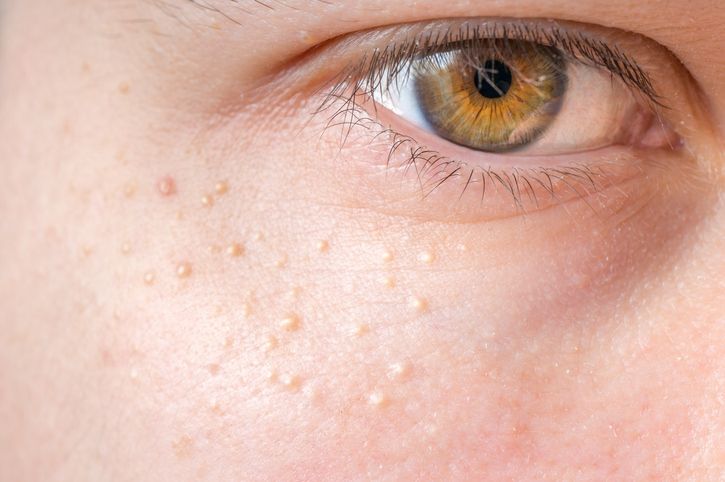- Home
- Trend
- Weight Loss Strategies
- Acne Tips
- Hair Health Information
- Blemish Removal Tips
- Acne Scar Removal Tips
- Muscle Building Techniques
- Intimate Care Tips
- Postpartum Intimate Care
- Eye Bags Wiki
- Tips for Face Slimming
- Secret of Permanent Hair Removal
- Breast Enlargement Tips
- Cure to Snoring
- Marionette Lines
- Skin-Tightening Secrets
When it comes to healthy slimming and achieving sustainable weight loss, it’s not just about following a healthy eating plan or adding more physical activity to your daily routine. There are numerous hidden challenges that can derail your progress if you're not careful. From mindset struggles to environmental factors, these obstacles can hinder your path to a healthier lifestyle.
1. Unrealistic Expectations

When beginning a weight loss journey, it's easy to set unrealistic goals, like expecting to drop a large amount of weight in a short time. This leads to frustration and disappointment when the progress doesn’t meet expectations.
Suggestion
Set smaller, achievable goals that prioritise healthy slimming over time. Instead of aiming for drastic weight loss, focus on losing 0.5–1 kg per week. This rate is sustainable and healthier in the long run.
Moreover, track non-scale victories such as increased energy, better sleep, or improved physical stamina, to keep yourself motivated.
2. Overeating Healthy Foods

Even when eating nutrient-rich foods, consuming too much can lead to weight gain. Foods like olive oil, nuts, and avocados are rich in healthy fats, but they’re also calorie-dense, which can unintentionally increase your calorie intake.
Suggestion
Practice portion control even with healthy foods. For example, measure your servings by using smaller plates or portioning out snacks in advance. A tablespoon of olive oil, a handful of nuts, or half an avocado can go a long way in providing nutrients without overloading on calories.
Additionally, use a food journal or app to track your daily intake to ensure you're maintaining a calorie deficit.
免費體驗
S6 Body Sculpting Treatment
1 Minute Self-Registration
Date should not be before minimal date
3. Emotional Eating
Stress, anxiety, boredom, or sadness often lead to emotional eating, where food becomes a source of comfort. This can result in turning to high-calorie snacks or sugary drinks, ultimately derailing your weight loss progress.
Suggestion
Identify your emotional eating triggers and develop healthier coping mechanisms. If stress leads you to overeat, try incorporating daily relaxation techniques like meditation, deep breathing, or going for a short walk.
Journaling can also be a useful outlet to express feelings without turning to food. When you feel the urge to emotionally eat, opt for engaging activities that don’t involve food, such as reading a book, calling a friend, or working out.
4. Skipping Meals
It’s a common misconception that skipping meals will help you lose weight faster. However, skipping meals—especially breakfast or lunch—can lead to intense hunger later in the day, resulting in overeating and metabolic imbalances.
Suggestion
Prioritise balanced meals throughout the day, ensuring that you’re nourishing your body with the energy it needs. Instead of skipping breakfast, opt for something simple yet nutritious like Greek yoghurt with fresh fruits or a smoothie packed with greens, protein, and healthy fats.
Keep healthy snacks on hand, such as baby carrots with hummus or a boiled egg, to prevent binge eating when hunger strikes later in the day. Meal prepping for the week can also help you avoid meal-skipping by having ready-to-eat options.
5. Overtraining
Exercise is crucial for weight loss, but overdoing it can lead to burnout, injury, and muscle fatigue. Overtraining can also spike your cortisol (stress hormone) levels, which might cause your body to retain fat, making weight loss harder.
Suggestion: Create a well-balanced workout routine that includes cardio, strength training, and rest days. Mix high-intensity exercises with lower-intensity workouts like yoga or swimming to give your muscles time to recover.
Recovery days are just as important as exercise days. Listen to your body—if you feel overly fatigued, it might be a sign to slow down or adjust your routine. Stretching and mobility exercises can also aid in recovery and prevent injury.
免費體驗
S6 Body Sculpting Treatment
1 Minute Self-Registration
Date should not be before minimal date
6. Focusing Only on the Scale
Tracking weight loss progress solely by watching the number on the scale can be misleading. As you build muscle and lose body fat, your overall weight might not change much, even though your body composition is improving.
Suggestion
Instead of just weighing yourself, track progress through multiple metrics. Take body measurements (waist, hips, arms), monitor how your clothes fit, or pay attention to performance improvements in your workouts (e.g., lifting heavier weights or running faster).
Besides that, monitor how you feel physically and mentally, as increased energy and better mood are also signs of progress. Keep a journal to record these changes weekly for a more holistic view of your journey.
7. Lack of Sleep
Sleep plays a major role in weight loss by regulating hunger hormones (ghrelin and leptin) and supporting energy levels. Poor sleep can lead to increased cravings for high-calorie foods, overeating, and a slower metabolism, making it harder to lose weight.
Suggestion
Prioritise 7–8 hours of quality sleep each night. Establish a consistent bedtime routine, which might include winding down without screens, reading a book, or practising relaxation techniques like deep breathing.
If you struggle to fall asleep, try creating a calming environment by keeping your bedroom cool and dark. Tracking your sleep quality with a fitness device can help you identify patterns and improve rest. Getting enough rest will boost your energy for workouts and help regulate hunger throughout the day.
8. Social Pressure
Dining out or attending social events can be challenging when trying to stick to a weight loss plan. Friends or family might encourage indulgence in high-calorie foods and sugary drinks, which can derail your progress.
Suggestion
Before social gatherings, plan ahead by reviewing restaurant menus and selecting healthier options. Opt for meals with lean proteins, vegetables, and whole grains. If you feel pressure to indulge, politely decline or take smaller portions.
Don’t be afraid to communicate your goals with friends or family members—they may be more supportive than you expect. You can also offer to bring a healthy dish to social events, ensuring there’s something that fits your dietary preferences. Eating a small, healthy snack before attending gatherings can also prevent overeating.
免費體驗
S6 Body Sculpting Treatment
1 Minute Self-Registration
Date should not be before minimal date
9. Ignoring Healthy Fats
In an effort to lose weight, many people cut out all fats from their diet, mistakenly believing they contribute to weight gain. However, healthy fats, such as those found in avocados, nuts, and olive oil, are essential for satiety and can aid in weight loss by keeping you fuller for longer.
Suggestion
Incorporate healthy fats into your meals while being mindful of portion sizes. For example, drizzle olive oil over your salad, add a few slices of avocado to your sandwich, or snack on a handful of nuts. These healthy fats can help curb hunger and prevent overeating.
However, since fats are calorie-dense, be conscious of the amount you’re consuming to avoid surpassing your calorie needs. Pairing healthy fats with lean proteins and fibre-rich vegetables can create satisfying, balanced meals.
10. Relying on Fad Diets
Fad diets often promise quick weight loss results but are rarely sustainable. These diets often restrict entire food groups or limit nutrient intake, leading to nutritional imbalances. While you may see short-term weight loss, it’s common to regain the weight once the diet ends.
Suggestion
Rather than following fad diets, focus on a balanced, sustainable approach to eating. Incorporate whole foods like fruits, vegetables, lean proteins, and whole grains into your meals. Practise mindful eating and maintain portion control.
Meal prepping and planning can help you stay consistent and avoid the temptation of fad diets. Remember that sustainable weight loss comes from long-term changes, not quick fixes, so aim for gradual, lasting progress instead of rapid, short-term results.
11. Metabolic Rate Decline
As you lose weight, your metabolism can slow down, which is your body's way of conserving energy. This natural response makes it harder to continue shedding pounds over time.
Suggestion
To combat a slowing metabolic rate, focus on incorporating strength training into your exercise routine. Building lean muscle mass can help boost your resting metabolism, meaning you’ll burn more calories even when you’re not working out.
On the other hand, remember to adjust your calorie intake as you lose weight—what worked when you started might need to be tweaked. Consider eating smaller, more frequent meals to keep your metabolism engaged throughout the day.
免費體驗
S6 Body Sculpting Treatment
1 Minute Self-Registration
Date should not be before minimal date
12. Hormonal Imbalances
Hormones like insulin, cortisol, and oestrogen are key players in fat storage, metabolism, and weight loss. An imbalance in these hormones, particularly in women, can significantly slow down fat loss, despite maintaining a healthy diet and exercise routine.
Suggestion
If you suspect hormonal imbalances are affecting your weight loss, consult a healthcare professional for testing and guidance. They may recommend specific treatments or lifestyle adjustments tailored to your body’s hormonal needs.
For example, managing stress, eating a balanced diet rich in fibre and healthy fats, and getting adequate sleep can help regulate hormones naturally. In some cases, medical intervention such as hormone replacement therapy (HRT) may be suggested to help you reach your weight loss goals.
13. Stress
Stress and weight gain are closely connected, primarily due to the role of cortisol, a hormone that the body releases in response to stress. When stress becomes chronic, cortisol levels remain elevated, leading to several physiological changes that make it difficult to slim down and lead to fat accumulation, particularly around the abdomen. Stress also triggers emotional eating, making it harder to stick to healthy eating habits.
Suggestion
Find healthy ways to manage stress, whether it's through exercise, meditation, yoga, or breathing exercises. Starting some meditation or exercise habits that calm your mind can reduce cortisol levels and prevent stress-induced weight gain.
Consider keeping a stress journal to identify patterns and triggers. By reducing stress, you'll make it easier for your body to respond to weight loss efforts and improve your mental well-being.
14. Genetics
Your genetic makeup plays a significant role in how your body stores fat and how easy or difficult it is for you to lose weight. Some individuals are predisposed to store fat in certain areas, like the hips or abdomen, regardless of their diet or exercise efforts.
Suggestion
While you can't change your genes, you can work with your body by adopting healthy eating habits and maintaining an active lifestyle. Strength training, cardio, and flexibility exercises can help you achieve the best version of yourself, despite any genetic predispositions.
Focus on the things you can control—like creating healthier eating habits and staying active. Embrace your unique body type and understand that progress is personal and looks different for everyone.
免費體驗
S6 Body Sculpting Treatment
1 Minute Self-Registration
Date should not be before minimal date
15. Stubborn Fat
Certain areas of fat, such as belly fat, arm fat, or thigh fat, are notoriously hard to lose, even when following a healthy diet and exercise plan. This can be discouraging when you're putting in effort for losing weight but not seeing results in specific areas.
Suggestion
For those struggling with slimming down specific areas despite healthy eating and exercise, the S6 Body Sculpting Treatment from Perfect Medical can be an ideal solution. This non-invasive treatment complements your weight loss journey by targeting stubborn fat that tends to accumulate in areas like the arms, thighs, and belly, where regular workouts and calorie control may fall short.
The advanced bio-laser technology of the S6 treatment works to break down fat cells, while vacuum suction helps expel them from the body, enhancing the natural slimming process. It’s especially useful for those aiming for a balanced and toned appearance without the need for surgery or extended recovery periods. By integrating this treatment with your existing physical activity and healthy eating patterns, you can maximise your results, improving body contours and overall silhouette.
The S6 treatment is also great for those maintaining a healthy lifestyle but seeking a more refined, sculpted look in areas that are typically resistant to diet and exercise alone!
Breaking the Obstacles: Healthy Weight is Achievable
Your healthy slimming journey may be filled with obstacles, but identifying them is the first step to overcoming them. As long as you address these challenges and remain consistent in your approach to healthy eating and physical activity, you can achieve lasting weight loss and optimal health. And if stubborn fat proves to be one of your hurdles, treatments like the S6 Body Sculpting Treatment offer a safe and effective way to complement your efforts. Start your way to lose weight now by making an appointment!
免費體驗
S6 Body Sculpting Treatment
1 Minute Self-Registration
Date should not be before minimal date
FAQ

1. How can eating fewer calories help start losing weight?
Eating fewer calories than your body needs creates a calorie deficit, which is essential for starting weight loss. When you consume fewer calories, your body responds by using stored fat for energy, helping you shed pounds. Focus on nutrient-dense, lower-calorie options like vegetables, lean proteins, and whole grains to maintain a balanced diet while reducing calorie intake.
2. What role do eating patterns play in managing eating disorders?
Establishing consistent and healthy eating patterns is crucial for managing eating disorders. Structured meals and snacks help stabilise blood sugar levels, reduce the urge to binge or restrict, and promote a balanced relationship with food. Following physical activity guidelines and focusing on nutrient-rich foods like plant-based options and whole grains can support recovery and long-term health.
3. How can a plant-based diet lower blood pressure?
Plant-based foods like fruits, vegetables, legumes, and whole grains are rich in fibre, vitamins, and minerals, which help lower blood pressure. These foods are also naturally low in saturated fats and sodium, reducing the risk of heart disease. Adopting a plant-based eating pattern alongside lifestyle changes like regular physical activity can lead to better blood pressure management.
4. How does reducing saturated fats and refined grains contribute to a healthy lifestyle?
Reducing saturated fats and refined grains can improve heart health and lower the risk of chronic diseases like heart disease and high blood pressure. Replacing them with healthy fats from sources like nuts, seeds, and olive oil, as well as whole grains, helps the body respond better to nutritional needs, promoting a healthier overall lifestyle.
5. How many calories should I consume to support a healthy lifestyle without risking an eating disorder?
The number of calories you need depends on factors like age, gender, activity level, and overall health. To support a healthy lifestyle, aim for a balanced intake that meets your nutritional needs without falling into restrictive eating patterns.








